Clinical Integration: Speciality Practice Report in Healthcare
VerifiedAdded on 2023/01/11
|6
|1396
|56
Report
AI Summary
This report examines the rights and responsibilities of nurses working in critical care, emphasizing the importance of patient safety and adherence to professional standards. The report presents a scenario involving a registered nurse, Mary, who makes a medication error due to personal stressors, leading to a near-fatal outcome for her patient, John, who suffered from a traumatic brain injury. The report highlights the critical role of nurses in providing safe care and adhering to ethical guidelines, as outlined by the Nursing and Midwifery Board of Australia. It underscores the significance of nurses' psychological well-being and resilience in preventing errors and protecting patients. The report references several studies and guidelines, including the Australian Commission on Safety and Quality in Healthcare, to emphasize the importance of medication safety and the impact of nurses' actions on patient outcomes. The conclusion reiterates the essentiality of patient safety in critical care and the need for nurses to uphold ethical and professional standards.
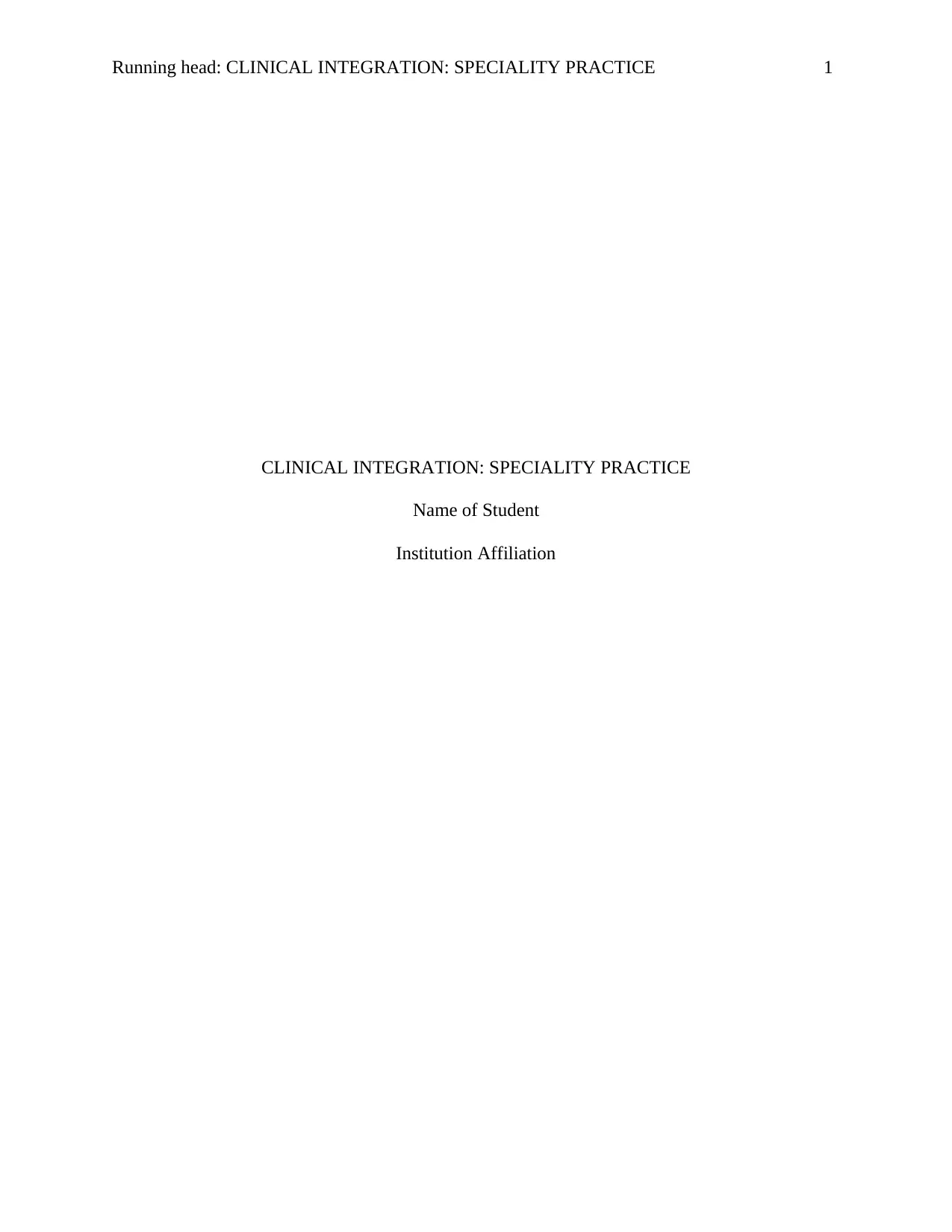
Running head: CLINICAL INTEGRATION: SPECIALITY PRACTICE 1
CLINICAL INTEGRATION: SPECIALITY PRACTICE
Name of Student
Institution Affiliation
CLINICAL INTEGRATION: SPECIALITY PRACTICE
Name of Student
Institution Affiliation
Paraphrase This Document
Need a fresh take? Get an instant paraphrase of this document with our AI Paraphraser
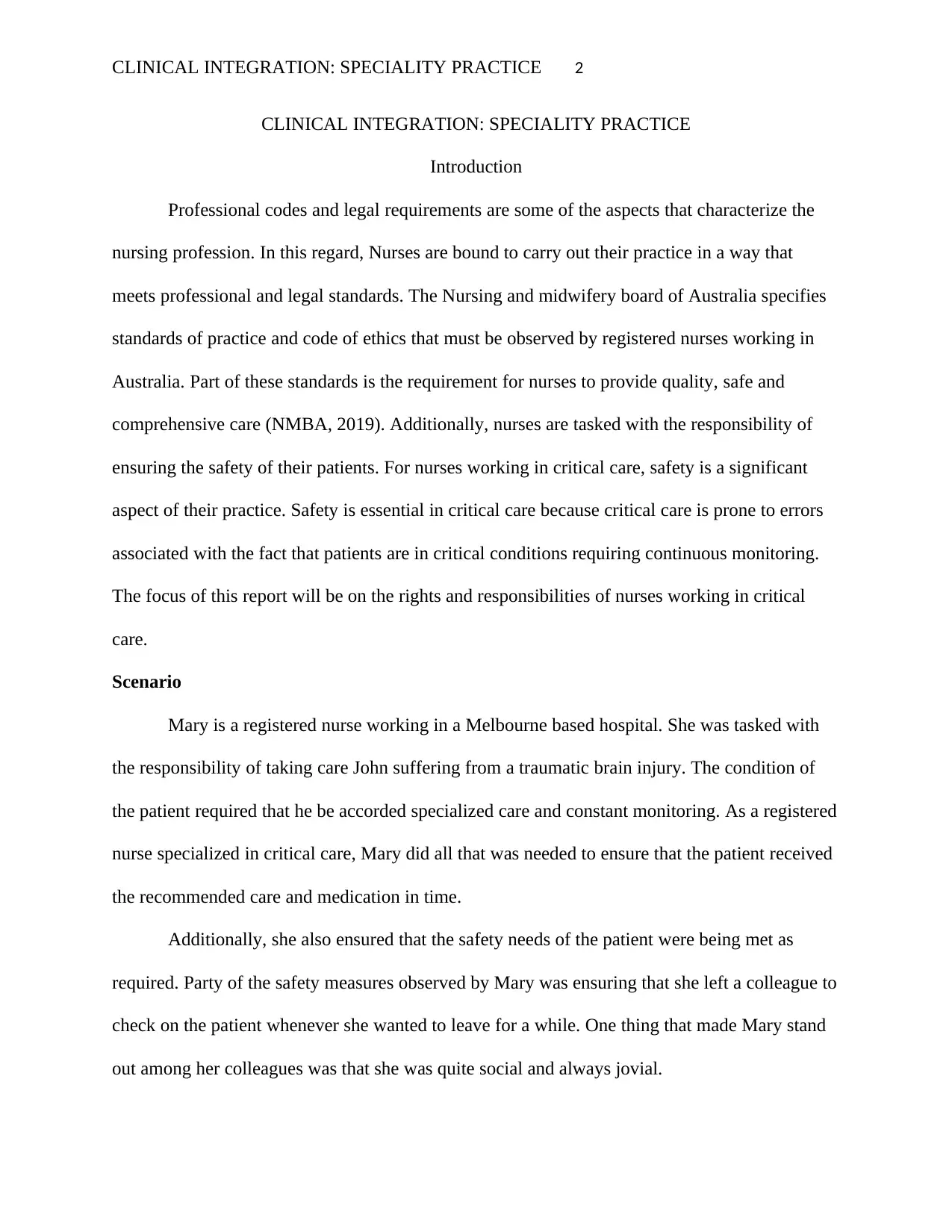
CLINICAL INTEGRATION: SPECIALITY PRACTICE 2
CLINICAL INTEGRATION: SPECIALITY PRACTICE
Introduction
Professional codes and legal requirements are some of the aspects that characterize the
nursing profession. In this regard, Nurses are bound to carry out their practice in a way that
meets professional and legal standards. The Nursing and midwifery board of Australia specifies
standards of practice and code of ethics that must be observed by registered nurses working in
Australia. Part of these standards is the requirement for nurses to provide quality, safe and
comprehensive care (NMBA, 2019). Additionally, nurses are tasked with the responsibility of
ensuring the safety of their patients. For nurses working in critical care, safety is a significant
aspect of their practice. Safety is essential in critical care because critical care is prone to errors
associated with the fact that patients are in critical conditions requiring continuous monitoring.
The focus of this report will be on the rights and responsibilities of nurses working in critical
care.
Scenario
Mary is a registered nurse working in a Melbourne based hospital. She was tasked with
the responsibility of taking care John suffering from a traumatic brain injury. The condition of
the patient required that he be accorded specialized care and constant monitoring. As a registered
nurse specialized in critical care, Mary did all that was needed to ensure that the patient received
the recommended care and medication in time.
Additionally, she also ensured that the safety needs of the patient were being met as
required. Party of the safety measures observed by Mary was ensuring that she left a colleague to
check on the patient whenever she wanted to leave for a while. One thing that made Mary stand
out among her colleagues was that she was quite social and always jovial.
CLINICAL INTEGRATION: SPECIALITY PRACTICE
Introduction
Professional codes and legal requirements are some of the aspects that characterize the
nursing profession. In this regard, Nurses are bound to carry out their practice in a way that
meets professional and legal standards. The Nursing and midwifery board of Australia specifies
standards of practice and code of ethics that must be observed by registered nurses working in
Australia. Part of these standards is the requirement for nurses to provide quality, safe and
comprehensive care (NMBA, 2019). Additionally, nurses are tasked with the responsibility of
ensuring the safety of their patients. For nurses working in critical care, safety is a significant
aspect of their practice. Safety is essential in critical care because critical care is prone to errors
associated with the fact that patients are in critical conditions requiring continuous monitoring.
The focus of this report will be on the rights and responsibilities of nurses working in critical
care.
Scenario
Mary is a registered nurse working in a Melbourne based hospital. She was tasked with
the responsibility of taking care John suffering from a traumatic brain injury. The condition of
the patient required that he be accorded specialized care and constant monitoring. As a registered
nurse specialized in critical care, Mary did all that was needed to ensure that the patient received
the recommended care and medication in time.
Additionally, she also ensured that the safety needs of the patient were being met as
required. Party of the safety measures observed by Mary was ensuring that she left a colleague to
check on the patient whenever she wanted to leave for a while. One thing that made Mary stand
out among her colleagues was that she was quite social and always jovial.
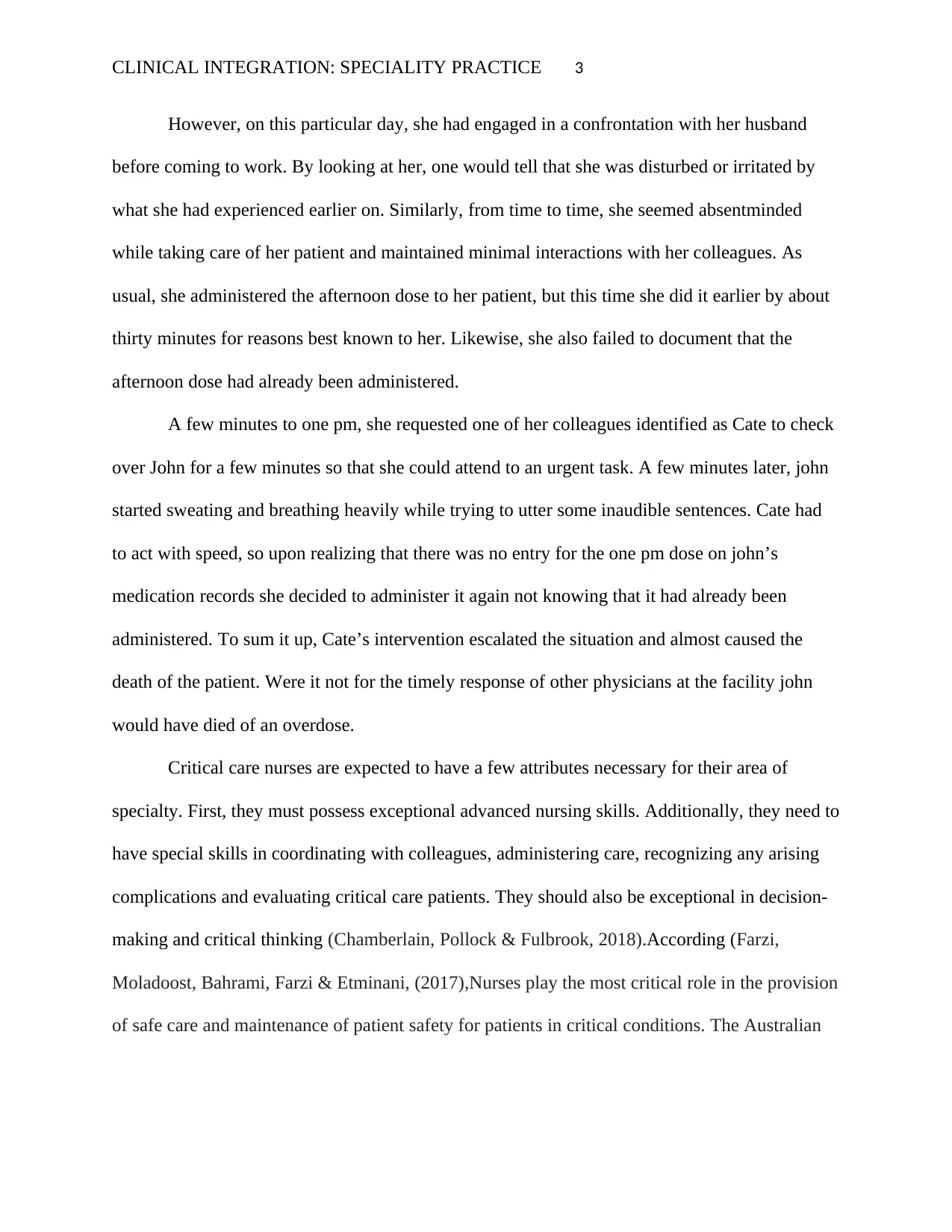
CLINICAL INTEGRATION: SPECIALITY PRACTICE 3
However, on this particular day, she had engaged in a confrontation with her husband
before coming to work. By looking at her, one would tell that she was disturbed or irritated by
what she had experienced earlier on. Similarly, from time to time, she seemed absentminded
while taking care of her patient and maintained minimal interactions with her colleagues. As
usual, she administered the afternoon dose to her patient, but this time she did it earlier by about
thirty minutes for reasons best known to her. Likewise, she also failed to document that the
afternoon dose had already been administered.
A few minutes to one pm, she requested one of her colleagues identified as Cate to check
over John for a few minutes so that she could attend to an urgent task. A few minutes later, john
started sweating and breathing heavily while trying to utter some inaudible sentences. Cate had
to act with speed, so upon realizing that there was no entry for the one pm dose on john’s
medication records she decided to administer it again not knowing that it had already been
administered. To sum it up, Cate’s intervention escalated the situation and almost caused the
death of the patient. Were it not for the timely response of other physicians at the facility john
would have died of an overdose.
Critical care nurses are expected to have a few attributes necessary for their area of
specialty. First, they must possess exceptional advanced nursing skills. Additionally, they need to
have special skills in coordinating with colleagues, administering care, recognizing any arising
complications and evaluating critical care patients. They should also be exceptional in decision-
making and critical thinking (Chamberlain, Pollock & Fulbrook, 2018).According (Farzi,
Moladoost, Bahrami, Farzi & Etminani, (2017),Nurses play the most critical role in the provision
of safe care and maintenance of patient safety for patients in critical conditions. The Australian
However, on this particular day, she had engaged in a confrontation with her husband
before coming to work. By looking at her, one would tell that she was disturbed or irritated by
what she had experienced earlier on. Similarly, from time to time, she seemed absentminded
while taking care of her patient and maintained minimal interactions with her colleagues. As
usual, she administered the afternoon dose to her patient, but this time she did it earlier by about
thirty minutes for reasons best known to her. Likewise, she also failed to document that the
afternoon dose had already been administered.
A few minutes to one pm, she requested one of her colleagues identified as Cate to check
over John for a few minutes so that she could attend to an urgent task. A few minutes later, john
started sweating and breathing heavily while trying to utter some inaudible sentences. Cate had
to act with speed, so upon realizing that there was no entry for the one pm dose on john’s
medication records she decided to administer it again not knowing that it had already been
administered. To sum it up, Cate’s intervention escalated the situation and almost caused the
death of the patient. Were it not for the timely response of other physicians at the facility john
would have died of an overdose.
Critical care nurses are expected to have a few attributes necessary for their area of
specialty. First, they must possess exceptional advanced nursing skills. Additionally, they need to
have special skills in coordinating with colleagues, administering care, recognizing any arising
complications and evaluating critical care patients. They should also be exceptional in decision-
making and critical thinking (Chamberlain, Pollock & Fulbrook, 2018).According (Farzi,
Moladoost, Bahrami, Farzi & Etminani, (2017),Nurses play the most critical role in the provision
of safe care and maintenance of patient safety for patients in critical conditions. The Australian
⊘ This is a preview!⊘
Do you want full access?
Subscribe today to unlock all pages.

Trusted by 1+ million students worldwide
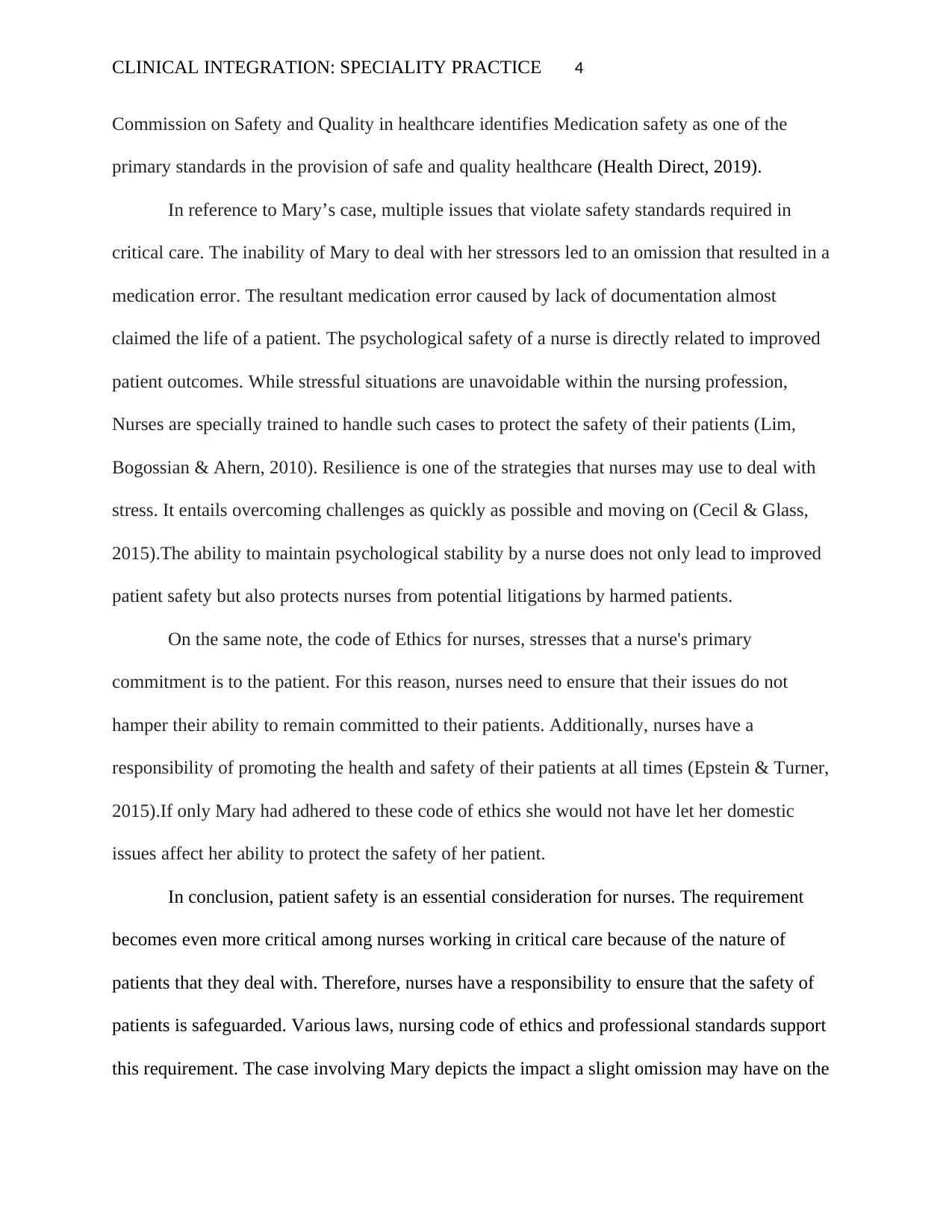
CLINICAL INTEGRATION: SPECIALITY PRACTICE 4
Commission on Safety and Quality in healthcare identifies Medication safety as one of the
primary standards in the provision of safe and quality healthcare (Health Direct, 2019).
In reference to Mary’s case, multiple issues that violate safety standards required in
critical care. The inability of Mary to deal with her stressors led to an omission that resulted in a
medication error. The resultant medication error caused by lack of documentation almost
claimed the life of a patient. The psychological safety of a nurse is directly related to improved
patient outcomes. While stressful situations are unavoidable within the nursing profession,
Nurses are specially trained to handle such cases to protect the safety of their patients (Lim,
Bogossian & Ahern, 2010). Resilience is one of the strategies that nurses may use to deal with
stress. It entails overcoming challenges as quickly as possible and moving on (Cecil & Glass,
2015).The ability to maintain psychological stability by a nurse does not only lead to improved
patient safety but also protects nurses from potential litigations by harmed patients.
On the same note, the code of Ethics for nurses, stresses that a nurse's primary
commitment is to the patient. For this reason, nurses need to ensure that their issues do not
hamper their ability to remain committed to their patients. Additionally, nurses have a
responsibility of promoting the health and safety of their patients at all times (Epstein & Turner,
2015).If only Mary had adhered to these code of ethics she would not have let her domestic
issues affect her ability to protect the safety of her patient.
In conclusion, patient safety is an essential consideration for nurses. The requirement
becomes even more critical among nurses working in critical care because of the nature of
patients that they deal with. Therefore, nurses have a responsibility to ensure that the safety of
patients is safeguarded. Various laws, nursing code of ethics and professional standards support
this requirement. The case involving Mary depicts the impact a slight omission may have on the
Commission on Safety and Quality in healthcare identifies Medication safety as one of the
primary standards in the provision of safe and quality healthcare (Health Direct, 2019).
In reference to Mary’s case, multiple issues that violate safety standards required in
critical care. The inability of Mary to deal with her stressors led to an omission that resulted in a
medication error. The resultant medication error caused by lack of documentation almost
claimed the life of a patient. The psychological safety of a nurse is directly related to improved
patient outcomes. While stressful situations are unavoidable within the nursing profession,
Nurses are specially trained to handle such cases to protect the safety of their patients (Lim,
Bogossian & Ahern, 2010). Resilience is one of the strategies that nurses may use to deal with
stress. It entails overcoming challenges as quickly as possible and moving on (Cecil & Glass,
2015).The ability to maintain psychological stability by a nurse does not only lead to improved
patient safety but also protects nurses from potential litigations by harmed patients.
On the same note, the code of Ethics for nurses, stresses that a nurse's primary
commitment is to the patient. For this reason, nurses need to ensure that their issues do not
hamper their ability to remain committed to their patients. Additionally, nurses have a
responsibility of promoting the health and safety of their patients at all times (Epstein & Turner,
2015).If only Mary had adhered to these code of ethics she would not have let her domestic
issues affect her ability to protect the safety of her patient.
In conclusion, patient safety is an essential consideration for nurses. The requirement
becomes even more critical among nurses working in critical care because of the nature of
patients that they deal with. Therefore, nurses have a responsibility to ensure that the safety of
patients is safeguarded. Various laws, nursing code of ethics and professional standards support
this requirement. The case involving Mary depicts the impact a slight omission may have on the
Paraphrase This Document
Need a fresh take? Get an instant paraphrase of this document with our AI Paraphraser
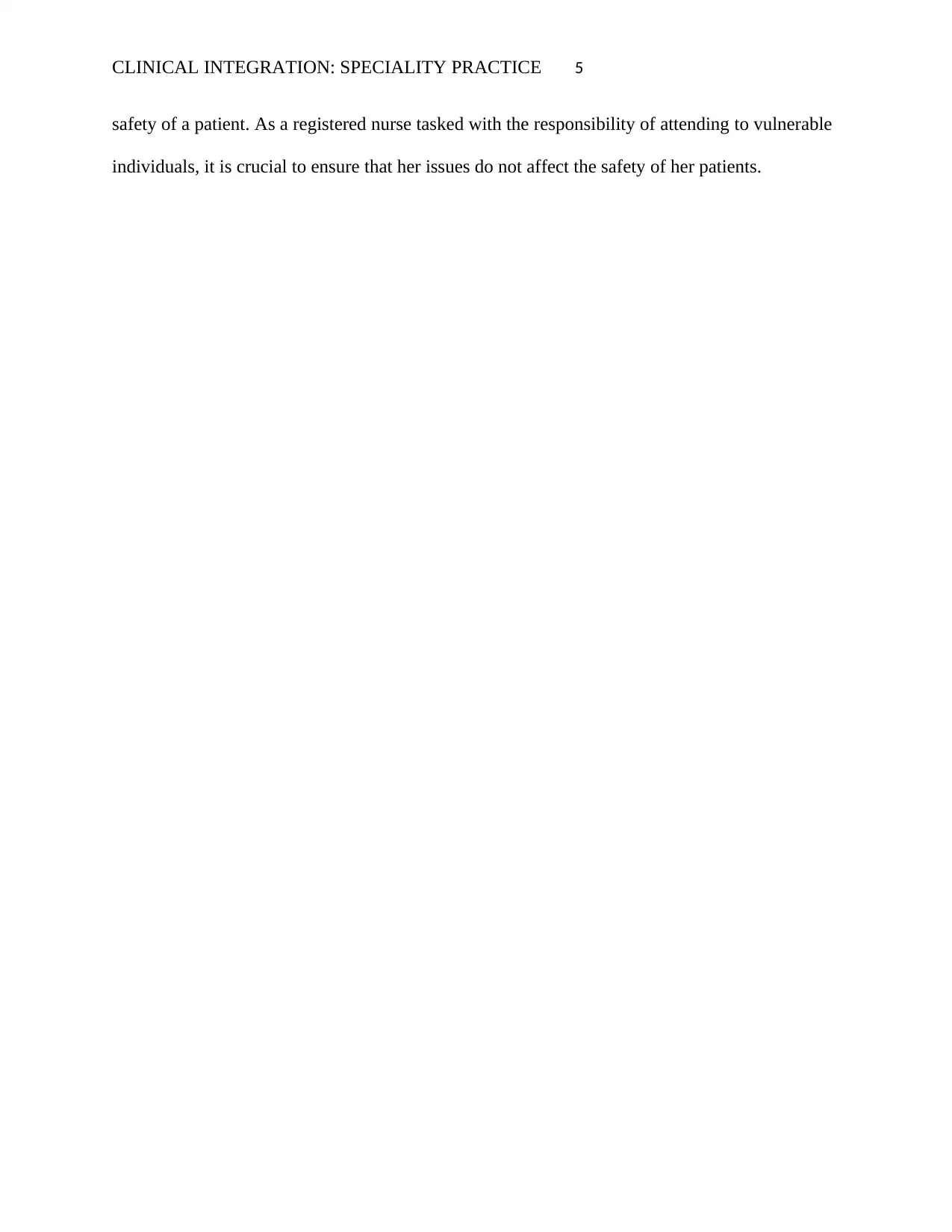
CLINICAL INTEGRATION: SPECIALITY PRACTICE 5
safety of a patient. As a registered nurse tasked with the responsibility of attending to vulnerable
individuals, it is crucial to ensure that her issues do not affect the safety of her patients.
safety of a patient. As a registered nurse tasked with the responsibility of attending to vulnerable
individuals, it is crucial to ensure that her issues do not affect the safety of her patients.
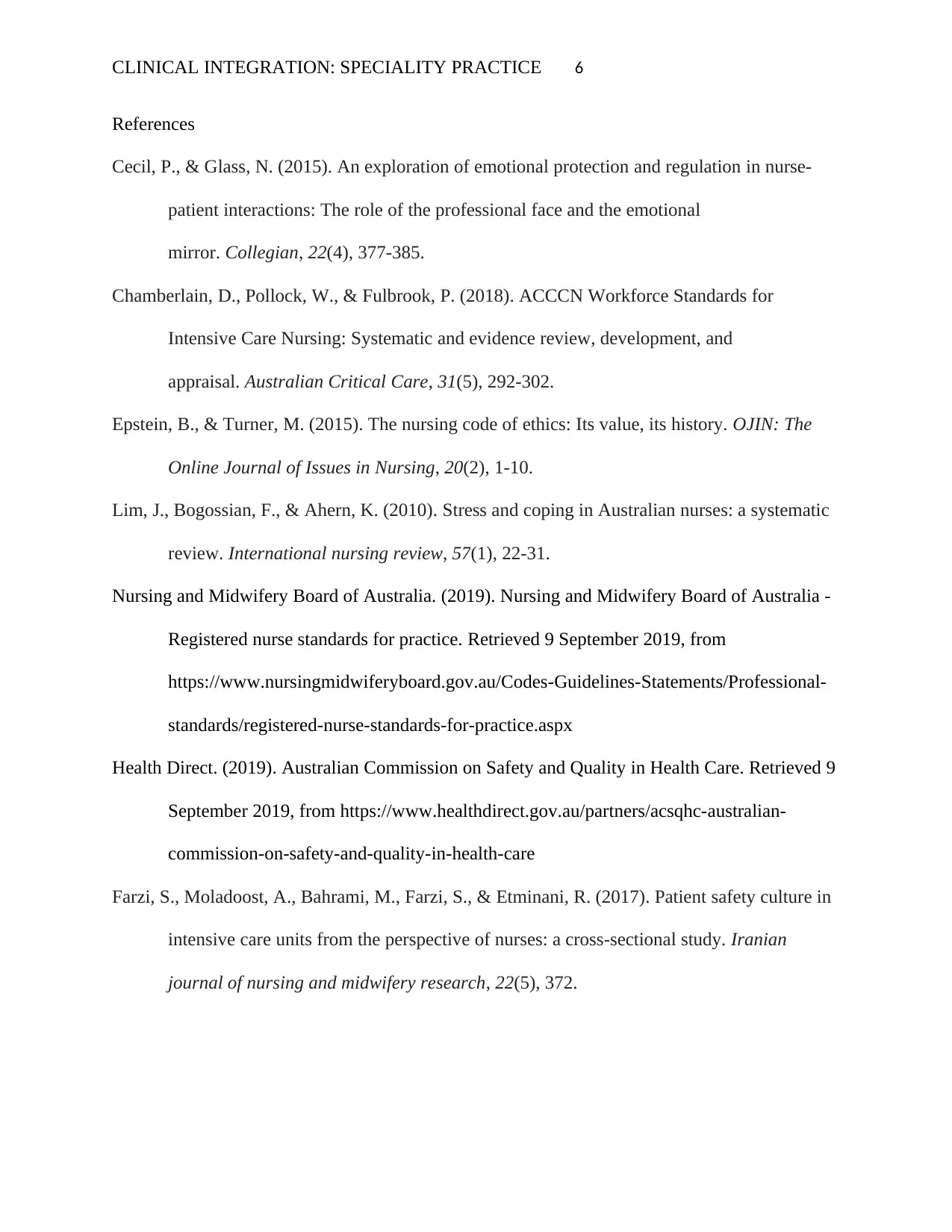
CLINICAL INTEGRATION: SPECIALITY PRACTICE 6
References
Cecil, P., & Glass, N. (2015). An exploration of emotional protection and regulation in nurse-
patient interactions: The role of the professional face and the emotional
mirror. Collegian, 22(4), 377-385.
Chamberlain, D., Pollock, W., & Fulbrook, P. (2018). ACCCN Workforce Standards for
Intensive Care Nursing: Systematic and evidence review, development, and
appraisal. Australian Critical Care, 31(5), 292-302.
Epstein, B., & Turner, M. (2015). The nursing code of ethics: Its value, its history. OJIN: The
Online Journal of Issues in Nursing, 20(2), 1-10.
Lim, J., Bogossian, F., & Ahern, K. (2010). Stress and coping in Australian nurses: a systematic
review. International nursing review, 57(1), 22-31.
Nursing and Midwifery Board of Australia. (2019). Nursing and Midwifery Board of Australia -
Registered nurse standards for practice. Retrieved 9 September 2019, from
https://www.nursingmidwiferyboard.gov.au/Codes-Guidelines-Statements/Professional-
standards/registered-nurse-standards-for-practice.aspx
Health Direct. (2019). Australian Commission on Safety and Quality in Health Care. Retrieved 9
September 2019, from https://www.healthdirect.gov.au/partners/acsqhc-australian-
commission-on-safety-and-quality-in-health-care
Farzi, S., Moladoost, A., Bahrami, M., Farzi, S., & Etminani, R. (2017). Patient safety culture in
intensive care units from the perspective of nurses: a cross-sectional study. Iranian
journal of nursing and midwifery research, 22(5), 372.
References
Cecil, P., & Glass, N. (2015). An exploration of emotional protection and regulation in nurse-
patient interactions: The role of the professional face and the emotional
mirror. Collegian, 22(4), 377-385.
Chamberlain, D., Pollock, W., & Fulbrook, P. (2018). ACCCN Workforce Standards for
Intensive Care Nursing: Systematic and evidence review, development, and
appraisal. Australian Critical Care, 31(5), 292-302.
Epstein, B., & Turner, M. (2015). The nursing code of ethics: Its value, its history. OJIN: The
Online Journal of Issues in Nursing, 20(2), 1-10.
Lim, J., Bogossian, F., & Ahern, K. (2010). Stress and coping in Australian nurses: a systematic
review. International nursing review, 57(1), 22-31.
Nursing and Midwifery Board of Australia. (2019). Nursing and Midwifery Board of Australia -
Registered nurse standards for practice. Retrieved 9 September 2019, from
https://www.nursingmidwiferyboard.gov.au/Codes-Guidelines-Statements/Professional-
standards/registered-nurse-standards-for-practice.aspx
Health Direct. (2019). Australian Commission on Safety and Quality in Health Care. Retrieved 9
September 2019, from https://www.healthdirect.gov.au/partners/acsqhc-australian-
commission-on-safety-and-quality-in-health-care
Farzi, S., Moladoost, A., Bahrami, M., Farzi, S., & Etminani, R. (2017). Patient safety culture in
intensive care units from the perspective of nurses: a cross-sectional study. Iranian
journal of nursing and midwifery research, 22(5), 372.
⊘ This is a preview!⊘
Do you want full access?
Subscribe today to unlock all pages.

Trusted by 1+ million students worldwide
1 out of 6
Related Documents
Your All-in-One AI-Powered Toolkit for Academic Success.
+13062052269
info@desklib.com
Available 24*7 on WhatsApp / Email
![[object Object]](/_next/static/media/star-bottom.7253800d.svg)
Unlock your academic potential
Copyright © 2020–2025 A2Z Services. All Rights Reserved. Developed and managed by ZUCOL.





